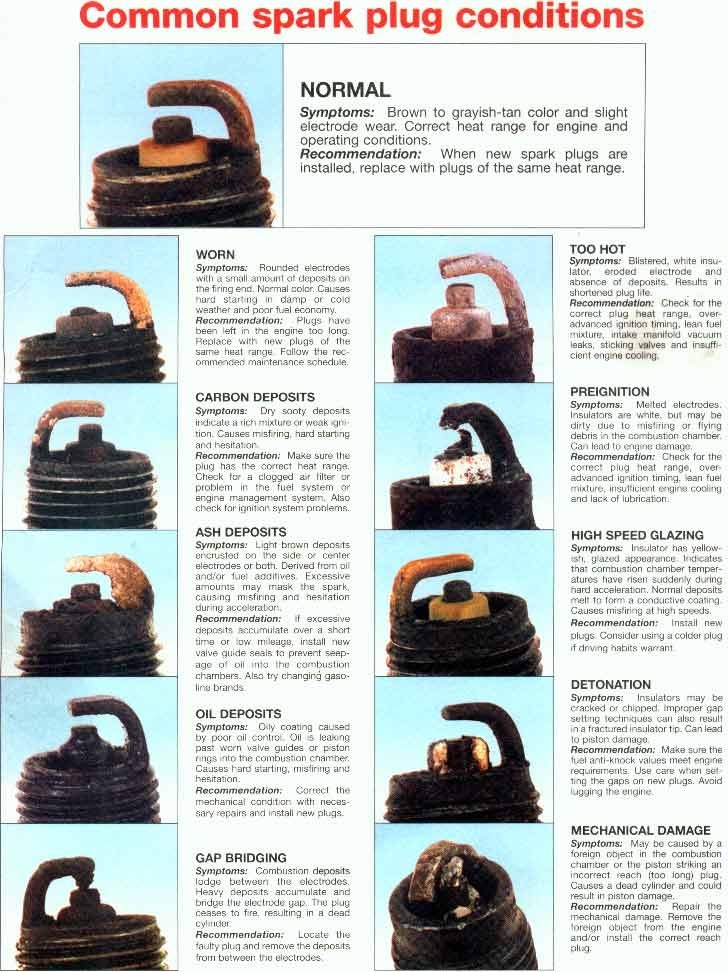Difference between revisions of "Spark plug fouling"
(Created page with " Category:Terminology <!-- Leave this line --> Category:Needs Collaboration <!-- Remove from this category once Wiki is more than 50% complete --> Category:Definitio...") |
|||
| (2 intermediate revisions by the same user not shown) | |||
| Line 1: | Line 1: | ||
| − | |||
[[Category:Terminology]] <!-- Leave this line --> | [[Category:Terminology]] <!-- Leave this line --> | ||
| − | |||
[[Category:Definitions]] | [[Category:Definitions]] | ||
| Line 9: | Line 7: | ||
==Definition== | ==Definition== | ||
| − | + | A [[spark plug]] is considered fouled when the insulator nose at the firing tip becomes coated with a foreign substance such as fuel, oil or carbon. | |
| + | |||
| + | Many factors can contribute to spark plug fouling. The air/fuel ratio may be too rich as a result of incorrect carburetor adjustment or a poorly performing fuel injection system. Worn piston rings or valve seals may allow too much oil to leak into the combustion chamber, leading to oil fouling. The ignition system may not be performing properly. Prolonged idling or continuous low-speed driving may keep the spark plug from reaching its optimum operating temperature. Using too cold a spark plug can lead to the same problem. Finally, a dirty air cleaner can create a too-rich condition which can lead to fouling. | ||
| + | |||
| + | Fuel, oil and carbon fouling can all be the result of different causes but, once a spark plug is fouled, it will not provide adequate voltage to the firing tip and that cylinder will not fire properly. In many cases, the spark plug cannot be cleaned sufficiently to restore normal operation. Therefore, it is recommended that a plug be replaced once it is fouled. | ||
| + | |||
| + | See the chart below to view what the different types of fouling look like on the spark plug. | ||
| + | |||
| + | [[Image:Sparkplugchart.jpeg|center]] | ||
| − | |||
{{Template:BottomWiki}} <!-- Do not remove this line --> | {{Template:BottomWiki}} <!-- Do not remove this line --> | ||
| Line 17: | Line 22: | ||
== [[References]] == | == [[References]] == | ||
| − | * | + | * https://www.ngksparkplugs.ca/tech-info-spark-plug-faq.cfm#sp5 |
Latest revision as of 03:36, 3 April 2020
Definition
A spark plug is considered fouled when the insulator nose at the firing tip becomes coated with a foreign substance such as fuel, oil or carbon.
Many factors can contribute to spark plug fouling. The air/fuel ratio may be too rich as a result of incorrect carburetor adjustment or a poorly performing fuel injection system. Worn piston rings or valve seals may allow too much oil to leak into the combustion chamber, leading to oil fouling. The ignition system may not be performing properly. Prolonged idling or continuous low-speed driving may keep the spark plug from reaching its optimum operating temperature. Using too cold a spark plug can lead to the same problem. Finally, a dirty air cleaner can create a too-rich condition which can lead to fouling.
Fuel, oil and carbon fouling can all be the result of different causes but, once a spark plug is fouled, it will not provide adequate voltage to the firing tip and that cylinder will not fire properly. In many cases, the spark plug cannot be cleaned sufficiently to restore normal operation. Therefore, it is recommended that a plug be replaced once it is fouled.
See the chart below to view what the different types of fouling look like on the spark plug.
Random Page | Longest Wikis | Oldest Wikis | Newest Images | Newest Wikis | List of Categories | List of Every Freakin Wiki
- Register to Edit
- It takes less than 5 minutes to request registration for editing, and we try to approve within 24 hours. Click the Register Link in the Top Bar.
- MoparWiki Help
- While editing Wikis may at first glance appear a little overwhelming, it really isn't. You will find this site's HELP (link found in the sidebar) to be very strong and easy to understand. The best way to start is with small edits and working on your user page -- and you will become a Pro in no time.

